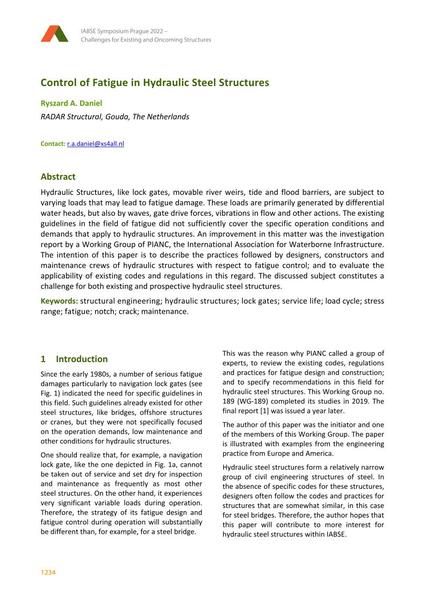Control of Fatigue in Hydraulic Steel Structures

|
|
|||||||||||
Bibliographic Details
| Author(s): |
Ryszard A. Daniel
(RADAR Structural, Gouda, The Netherlands)
|
||||
|---|---|---|---|---|---|
| Medium: | conference paper | ||||
| Language(s): | English | ||||
| Conference: | IABSE Symposium: Challenges for Existing and Oncoming Structures, Prague, Czech Republic, 25-27 May 2022 | ||||
| Published in: | IABSE Symposium Prague 2022 | ||||
|
|||||
| Page(s): | 1234-1241 | ||||
| Total no. of pages: | 8 | ||||
| DOI: | 10.2749/prague.2022.1234 | ||||
| Abstract: |
Hydraulic Structures, like lock gates, movable river weirs, tide and flood barriers, are subject to varying loads that may lead to fatigue damage. These loads are primarily generated by differential water heads, but also by waves, gate drive forces, vibrations in flow and other actions. The existing guidelines in the field of fatigue did not sufficiently cover the specific operation conditions and demands that apply to hydraulic structures. An improvement in this matter was the investigation report by a Working Group of PIANC, the International Association for Waterborne Infrastructure. The intention of this paper is to describe the practices followed by designers, constructors and maintenance crews of hydraulic structures with respect to fatigue control; and to evaluate the applicability of existing codes and regulations in this regard. The discussed subject constitutes a challenge for both existing and prospective hydraulic steel structures. |
||||
| Keywords: |
fatigue crack service life structural engineering maintenance stress range load cycle notch hydraulic structures
|
||||
| Copyright: | © 2022 International Association for Bridge and Structural Engineering (IABSE) | ||||
| License: | This creative work is copyrighted material and may not be used without explicit approval by the author and/or copyright owner. |
||||
